1985-2008
Focus on Poetry
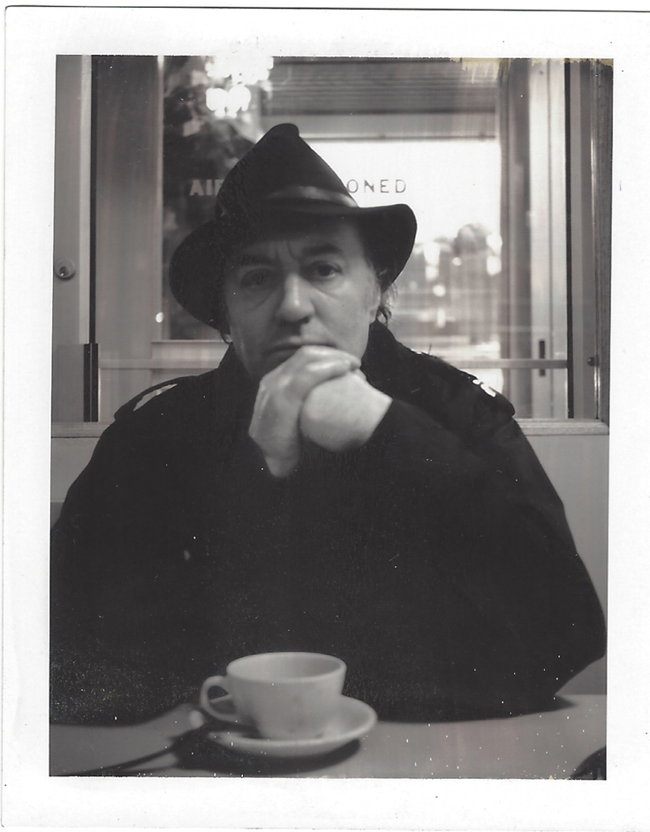
Aldo, NYC coffee shop, 1987
1985-1987
Tambellini left MIT and shifted his focus to poetry, embarking on a journey to uncover his poetic voice. This led him to read his poetry to various audiences, including the homeless in Cambridge’s Central Square, Goodwill shoppers and employees, and veterans spending their days on benches. As he immersed himself in the world of poetry, Tambellini participated in readings in Massachusetts and New York, reconnecting with fellow poets from the 1960s like Askia Toure and Ishmael Reed of the UMBRA Poets. He became an active member of the poet community, attending readings and forming bonds with like-minded individuals who shared his passion for political activism, antiwar movements, and helping the marginalized.
1988-1989
Tambellini created his Black Energy Suspended Series,
works on found architectural paper
"In 1988-89 I found several discarded rolls of architectural paper which had graphic lines and symbols. Selecting certain ones, I laid them on the floor of my apartment and painted as traditional Chinese or Japanese artists would do-the paper on the floor, I on my knees, using black acrylic paint, wax, and powder graphite and no white.
"Responding intuitively with quick automatic gestures, being aware of the printed symbols and other signs existing on the paper and integrating these into the process allowing no change. Sometimes, I used implements to make incisions on the surface. Each image which I worked on led to the next painting in a sequential order as I had painted each frame of the 'Black Film Series' in the 1960’s. I call this series of approximately 175 pieces, 'Black Energy Suspended Series’.”
-Aldo Tambellini, 1989
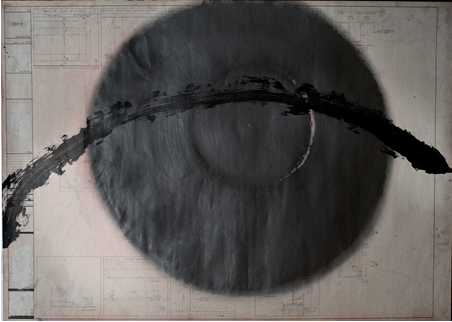
A-430, from Black Energy Suspended Series, 1989
acrylic on architectural paper, 30x42 in.
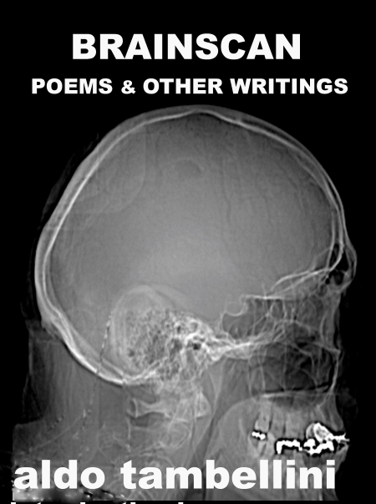
Cover (Tambellini’s actual brainscan) of Tambellini’s unpublished book, completed 2020
1990-1992
Feeling inspired, Tambellini began a ritual of waking up each morning, sitting at his typewriter and writing poems and prose for his poetry book, Brainscan 90.
“The exercise of writing poetry brought me back to my old way of expressing myself. My first poems were written when I was sixteen and I continued to use verse as an expression through the 60s, when I published The Screw newsletter in poetry form.”
-Aldo Tambellini
Encouraged by his poetic expression, Tambellini began reading in many poetry venues in Boston, MA New York City, NY and Hartford, CT.
1993-1995
While spending time in Cambridge's Central Square, Tambellini formed a friendship with Tasha, a beautiful, twenty-year-old woman known for her tough and unforgiving nature. Tasha provided Tambellini with insight into her life’s reality, marked by destitution, the frequent transitions between homeless shelters, interactions with drug dealers, run-ins with the authorities, illicit behaviors, and the heartbreaking deaths of youth.
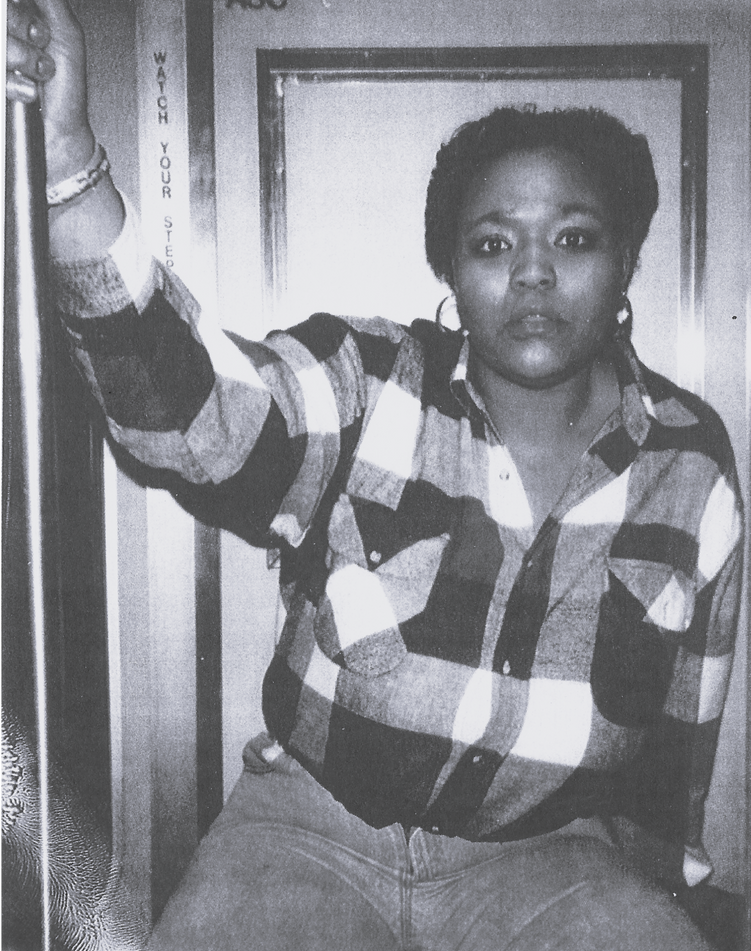
Tasha, ca. 1990s
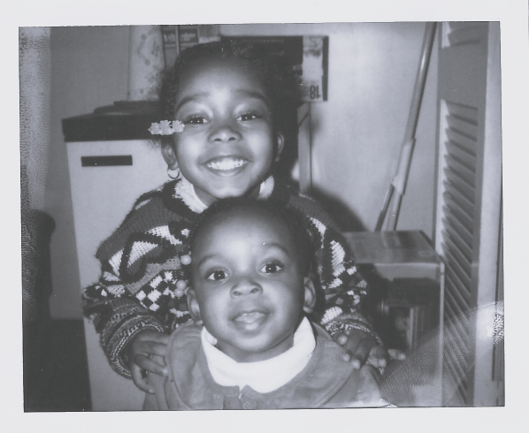
Sisters, Mayelle and Marissa, ca. 1994
Tambellini met Tasha's daughter, Mayelle, a two-year-old child, whom he grew to care for deeply. He stepped into a fatherly role for her, regularly taking care of Mayelle, in their shelter, while Tasha was out navigating life on the streets of Cambridge. Shortly after meeting Tasha, her second daughter, Marissa, was born. Tambellini met Marissa the day after her birth and, just like with Mayelle, he felt an instant connection and love for her.
Tambellini, driven by his deep emotional bond to Mayelle and Marissa, penned a compilation of affectionate and tender poems, resulting in an unpublished anthology titled A Fist Full of Poems for Mayelle and Marissa.
1996
The sudden death of his love and partner, Sarah Dickinson, resulted in Tambellini being admitted to a mental institution. This would be one of a number of times Tambellini would require mental health services.
Tambellini's despair over Sarah's loss consumed him entirely, causing him to neglect all aspects of his life, including his relationship with Tasha, Mayelle and Marissa and most importantly, his own desire to continue living. During this period, he ceased making sporadic payments to the storage facility in Albany, NY, where his artistic creations from the 60's and 70’s were kept. The realization that he had abandoned his life's work tormented him for years, haunting his dreams with visions of its loss and destruction. He awakened from these nightmares in a state of anguish, overwhelmed by a profound sadness that plunged him into episodes of depression.
“How can I claim to be an artist when I have lost most of my work or it has been destroyed, what do I have to show for all of those years I created?”
-Aldo Tambellini

Tambellini’s original draft of the cover for People’s Poetry, Issue #1
1997-1998
Tambellini continued to battle with depression. In search of solace, he turned to poetry as a means to cope. He organized a venue of his own called the “People’s Poetry.” This became a workshop for new poets, a place where they would feel secure and comfortable to recite their works. A performance space was created where poetry, at times, was combined with song and music. Known for its inclusivity, individuals would contribute whatever amount they could in order to obtain entry.
1999
Tambellini was a founding member of Liberation Poetry Collective, Poets against the killing fields. The collective began to create and publish anti-war and social-political poetry books.
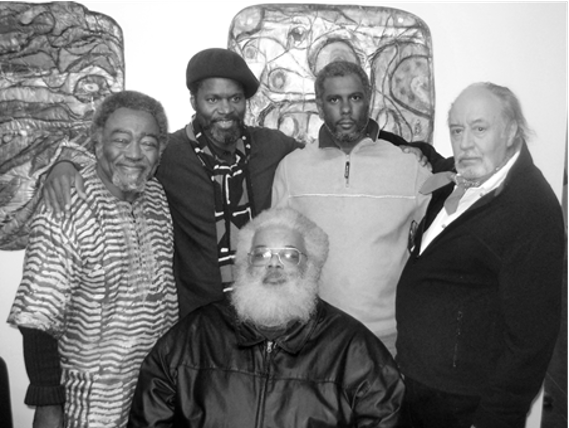
Tambellini with members of Liberation Poetry Collective, ca. 2017
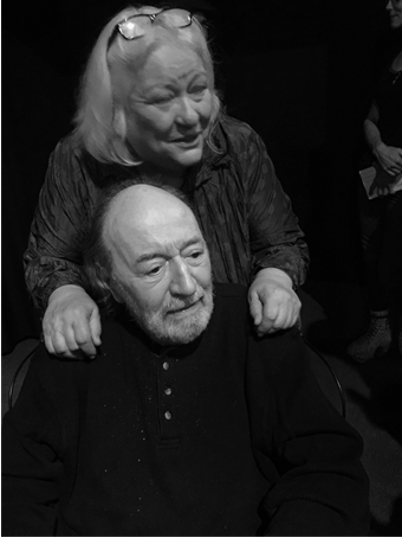
2000
Tambellini met Anna Salamone, his life partner until his passing in 2020
2003
Through his poetry, Tambellini started to reveal his life with Tasha, Mayelle, and Marissa to Anna. With support and encouragement, Tambellini made the decision to reach out and reestablish connections with Mayelle and Marissa, resulting in a heartwarming reunion. Tambellini maintained a relationship with the girls until his passing.
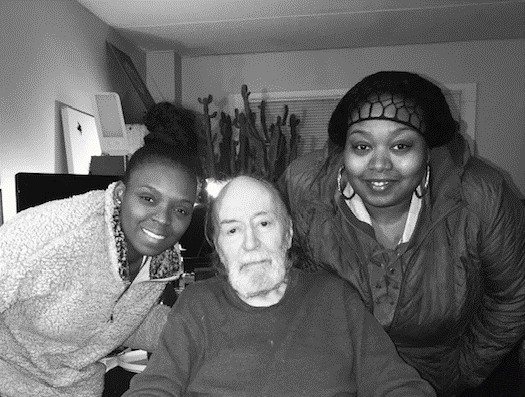
Tambellini with Marissa and Mayelle, 2019
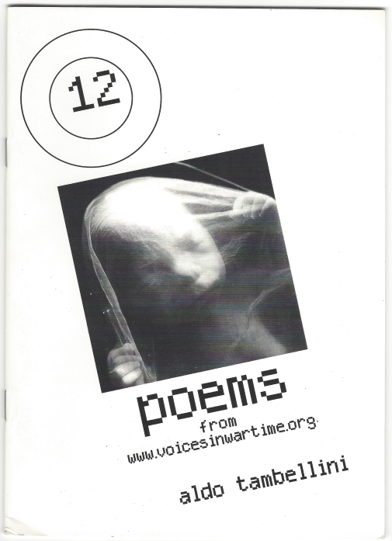
2005-2006
In 2005, Tambellini published his first poetry book,
12 poems
from
www.voicesinwartime.org
Tambellini was diagnosed with a heart condition and was in need of immediate surgery. At the same, Anna found and retrieved some of Tambellini’s abandoned art work. She was able to bring some pieces back to Tambellini, right before his surgery. Encouraged by seeing the artwork, Tambellini's morale improved significantly and enabled him to fully recuperate.
Inspired by seeing his old work, and feeling frustrated by the propgandized portrayal of the Iraq War on television with its tag line, “Shock and Awe,” Tambellini revisited his artistic roots. In collaboration with Anthony Tenczar in 2005, he produced a digital film titled
LISTEN, which combined his anti-war sentiments, political poetry, and various forms of visual media to document the devastating effects of war.
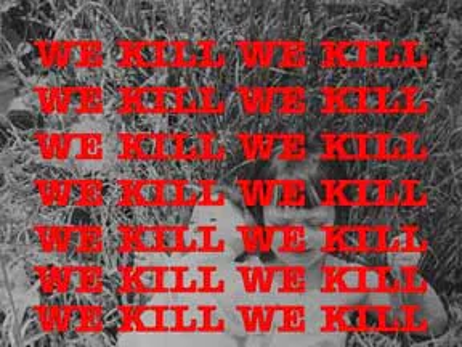
Tambellini’s visual poem, the last frame of the video, Listen, 2005.
Tambellini’s digital film, LISTEN, won the New England Film Festival, Best Experimental Film 2005 and is the Winner of the Syracuse International Film Festival, Best Experimental 2006.
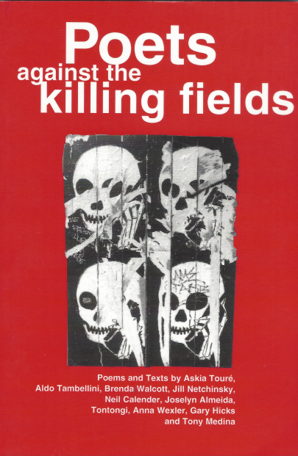
2007
Tambellini is included in, Poets against the killing fields, the first poetry collection, published by the Liberation Poetry Collective.
Tambellini is awarded the “Lifetime Achievement Award” from Syracuse University at the 2007 Syracuse International Film Festival.
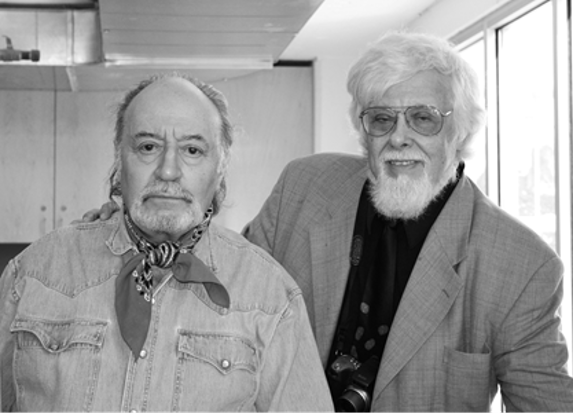
Tambellini (left) with best friend, James Wines at Tambellini’s ceremony, at Syracuse University, when Tambellini received his Lifetime Achievement Award for film and video. 2007
The same year Tambellini received the Keys to the City of Cambridge from Mayor Ken Reeves in recognition of his contribution to the cultural environment of Cambridge.
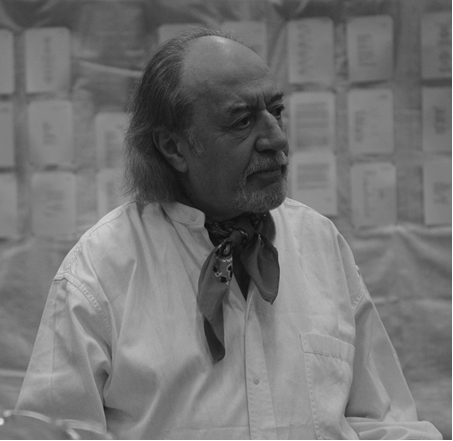
Tambellini reading poetry at the Passaglia Art Institute, Lucca, Italy, 2007
Tambellini was asked to participate in the 2007 Lucca Film Festival, where his Black Films were screened.
Tambellini was invited by the headmaster of his childhood Art Academy, Passaglia Art Institute, to showcase his artwork, recite poetry, conduct instructional sessions, and engage in a Q&A session, while in Lucca for the film festival.
“I am, also, impressed by the Italian Futurists, Marinetti, in particular, who freed the form of poetry and created wonderful sound poems with his writings. Like Marinetti, I have lately worked on freeing my poetry from its standard text and confinement to a page of a publication. I have reached back to my years creating “electromedia” experiences for the observers and have taken an approach that my poetry can be part of a whole experience for people. I am now using my poetry in form of moving or stagnant projections as part of my new art installations. My poetry is seen on the floor, the walls and even projected in a manner where people’s bodies are enveloped in the writing as they move around the installation. The installation created for my retrospective exhibition at ZKM-in Karlsruhe, Germany had my early circular poems projected on the floor and lines from my poetry integrated in the soundtrack that accompanied the installation. My poetry has finally integrated itself into the life of my installations and has become an integral part of my artistic expression.
Likewise I have freed my poetry from the confines of the English language as I have started collaborating with artists/performers around the world who have translated my poetry and in this collaborative efforts of mutual creativity my poems are being integrated into art pieces or performances.”
-Aldo Tambellini, 2017
NEXT CHRONOLOGY CHAPTER
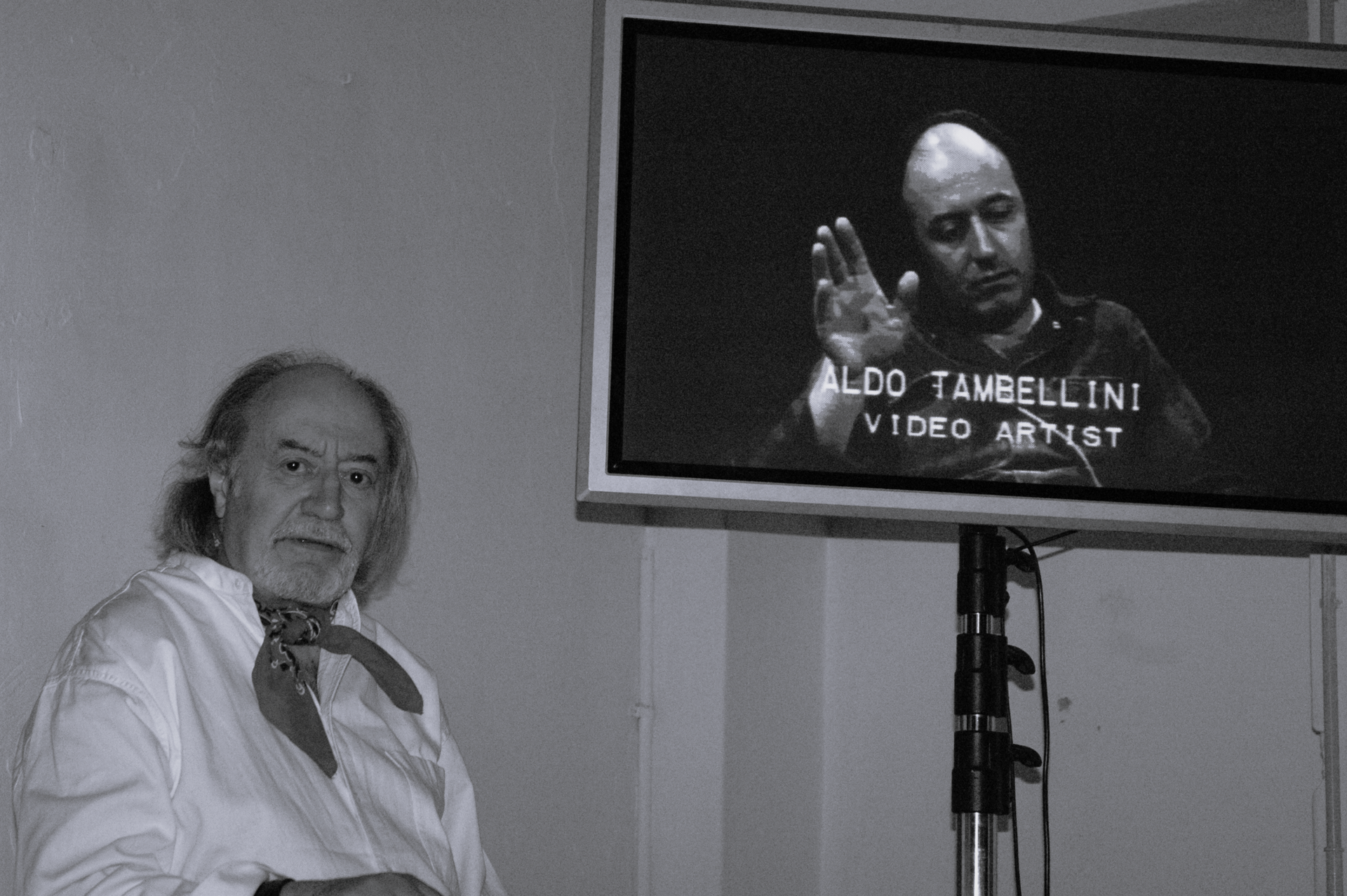
2008 – 2020
Rediscovered
In 2008,Tambellini's artistic contributions were rediscovered and welcomed by the art establishment that he had denounced throughout his life. His reemergence began with a retrospective of his films and videos at the Anthology Film Archive, NY, in the “Circuit Off” Program. The reperformance of his 1965 “Electromedia” event Black Zero at Performa 09 came shortly thereafter. That event was followed by solo shows at the Chelsea Art Museum, Black Zero, in 2011, Retracing Black, a large-scale installation accompanied by live performances at Tate Modern in 2012, Centre Pompidou, Aldo Tambellini Series: Back to Black in 2012,and We Are The Primitives Of A New Era, Paintings and Projections 1961-1989 at James Cohan Gallery, 2013. He was included in the Study of Internal Shapes and Outward Manifestations exhibit, in the Italian Pavilion at the 2015 Venice Biennale. In 2017 he exhibited Black Matters, the first full solo exhibition of American artist, Aldo Tambellini, one of the pioneers of intermedia art of the 1960s and 1970s at The ZKM | Center for Art and Media Karlsruhe. At the end of Tambellini’s life, he was able to revisit his notebooks from the 60s, using them for inspiration, he completed his final creation, We are the Primitives of a New Era, a VR immersive project.
We use cookies to ensure that we give you the best experience on our website. To learn more, go to the Privacy Page.


